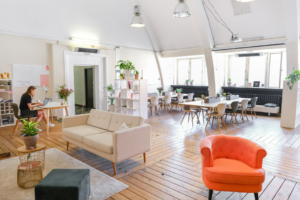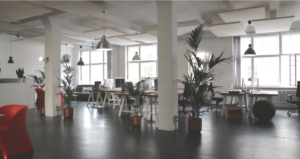With global industry leaders questioning how exactly our workspaces will operate in the future, it is essential that offices make the best possible use of their space. In addition, 37% of job candidates will take a lower salary if the company offers an appealing work environment.
With COVID-19 threatening the ‘classic office floorplan’ and, ultimately, business productivity, we reached out to our multi-award-winning interior design business coaches for their take on what the future holds
Do ‘open space’ offices decrease productivity, and is there a type of space that has been shown to increase productivity?
 Once considered futuristic, ‘open space’ offices are now the norm in almost all corporate settings and seem to be a common feature in most SME’s in the UAE. Open spaces continue to be popular, despite research showing they don’t boost productivity. However, with concerns about the spread of the virus and support for focused work, the open space office is in for a change.
Once considered futuristic, ‘open space’ offices are now the norm in almost all corporate settings and seem to be a common feature in most SME’s in the UAE. Open spaces continue to be popular, despite research showing they don’t boost productivity. However, with concerns about the spread of the virus and support for focused work, the open space office is in for a change.
JBM’s interior design expert and mentor, Priyaa Telavvane, suggests that having designated areas dedicated to focused work can support teamwork and collaboration whilst creating space for people to work separately. Specifically, she suggests that, “break out rooms and informal meeting hubs often cut potential ‘hierarchical restrictions’ and can encourage an atmosphere for creative freedoms to flourish. However, this ultimately depends on the company culture, the nature of the business and the individuals involved.”
Similarly, interior design expert Indu Varanasi indicates that the verdict is still out on open design spaces and productivity. “The design of each office is different, with a balance of acoustically controlled spaces and open collaboration areas. Requirement determines usage patterns of either space,” she says. More than layout, Indu recommends the careful selection of materials and their sound absorbency whilst designing to ensure that a space serves its desired function.
Can region-specific preferences affect productivity?
Climate, culture and lifestyle change from region to region, and it should come as no surprise that the work system and office culture would change as well. Variations in culture and environment would mean that what would be common in Scandinavia might not work in Southeast Asia. According to Priya, planning, structural limitations and material sourcing also plays a major role in regional variations across work spaces around the world.
“Colour preferences vary across regions and can differ wildly, from subtle ‘tatami’ hues to vibrant topaz greens, and influence how clients and workers view a space,” she says. “For example, positioning add-ons like plants closer to a pantry or recreational area can set a mood and affect energy patterns,” she adds.
Indu also notes the importance of assessing how privacy and client interaction are viewed in the region, “Whilst the effect of globalization is visible across design, local cultures and specific client requirements play a significant role. Quiet spaces and private areas can be very culture dependent, and sensitive to specific businesses. requirements.”
What are some cost-effective ways businesses can immediately improve productivity within their current office?
 Indu is a strong believer in the ethos of modernist architect L. Mies Van de Rohe: Less is, indeed, more! Priya agrees that reducing clutter and maximising how you use your existing space more efficiently is an easy way to increase an office’s work flow. She suggests simple measures, such as carving out open communal areas using both creative furniture arrangement and light variations. Introducing green elements and seeking colour consultations can also have a marked effect on the atmosphere and ambience of your workplace.
Indu is a strong believer in the ethos of modernist architect L. Mies Van de Rohe: Less is, indeed, more! Priya agrees that reducing clutter and maximising how you use your existing space more efficiently is an easy way to increase an office’s work flow. She suggests simple measures, such as carving out open communal areas using both creative furniture arrangement and light variations. Introducing green elements and seeking colour consultations can also have a marked effect on the atmosphere and ambience of your workplace.
Indu also stresses the importance of taking “general precautions towards good hygienic practices.” Productivity relies on both the physical and mental health of your workforce. “Consider adjusting desk numbers, minimise unnecessary stationary and ensure all surfaces are frequently and effectively sanitized. This includes carpets, air conditioning ducts and filters,” she adds.
To set up a consultation with our expert mentors, book a FREE session with –




